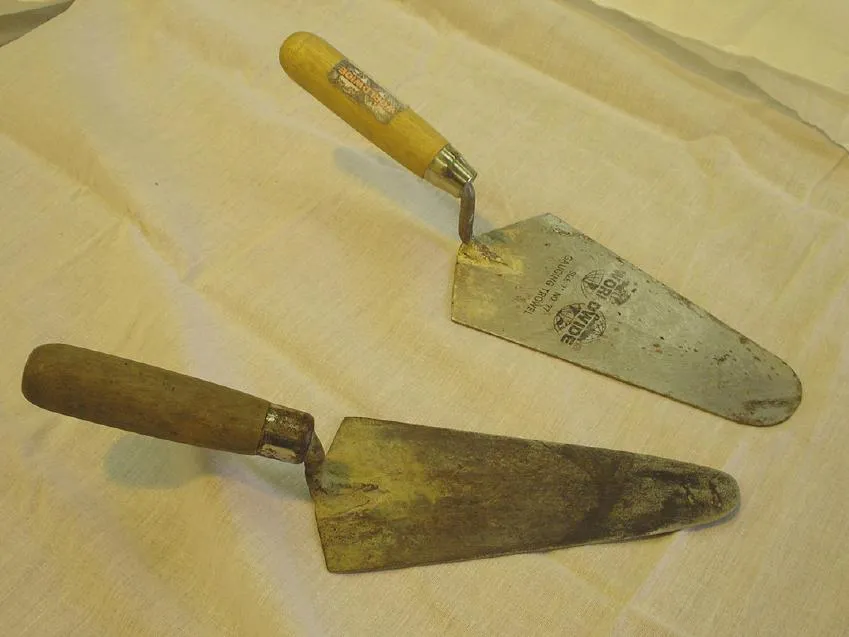CHAPTER 1
Tools and Equipment
This chapter deals with the tools and equipment needed and advice on how to make the right choices.
HAND TOOLS
The tools in a roofer, slater and tiler’s bag or tool box will vary from firm to firm and from region to region, and so will the terminology describing them. The list below is from my own tools and those which are most commonly used throughout the industry. Much, of course, depends on the type of work you are doing, so I have included a brief description of what each tool is used for to help you decide what you may or may not need.
Measuring Tape
Retractable tapes come in all sorts of quality and length, but for measuring roofs and for general use go for a heavy-duty, retractable tape in excess of 7m long.
Folding Rule
Many roofers (including me) prefer to use a folding rule rather than a tape in certain situations. Go for a 1m folding rule that shows metric and, if possible, imperial measurements as well.
Gauging Trowel
The trowel most commonly used by roofers is the gauging trowel (about 175mm in length). It is big enough to bed mortar with and small enough to point with. Go for a forged trowel, which means that the blade and the handle are all of one piece of metal; the cheaper ones are welded together and not really robust enough for roofing work.
Nail Pouch
There is a wide variety of nail pouches available, some are more tool belts than pouches and, while the odd extra pocket or loop is handy at times, a simple nail pouch with two separate compartments should be fine in most situations. This will allow you to separate batten nails and clout nails for ‘lathing and felting’ and then tile and slate nails and clips (if applicable) when fixing the roof covering.
Chalk Line/Wet Red Line
Lines are useful for striking lines when battening and setting out for tiling, for example. If you are using a wet line choose one that is quite stiff, absorbent (that is, not nylon) and well made. The sign of a good line is that it does not separate when twisted backwards and forwards in the fingers. The colouring used is normally red cement dye mixed with water. If you prefer a chalk line then buy a heavy duty one and fill it with a coloured chalk.
Trimming Knife
This is still commonly referred to in the trade as a ‘Stanley knife’, although that is strictly a trade name. They are used mainly for cutting underlay. Straight blades will cut most types of felt and underlay, but if you are using bituminous felt I would recommend hook blades.
Cordless Drill/Screwdriver
By all means have a manual drill and a few straight and cross-bladed screwdrivers in your tool bag as a backup and for small jobs, but, if you are going to be doing a lot of dry fix or installing roof windows, then a cordless drill (the higher the voltage the better) plus a selection of masonry bits and screwdriver bits are essential.
Slater’s ‘Break or Bench’ Iron and Slate Knife
A break iron is basically an anvil for cutting natural slates in conjunction with a slate knife. These are the traditional tools used to cut slates and are still widely used, despite the introduction of hand-held cutters, especially when it comes to the heavier, thicker slates.
Slate-Holing Machines
Now many natural slates come pre-holed, but you do pay a premium for that service and there are some occasions when it is preferable to hole the slates yourself. Slate-holing machines can have a punch- or borer-type action and come with adjustable guards to set the holing position. Traditionally, a slater’s apprentice or labourer would set up a bench with a break iron, slate knife and holing machine and it would be his job to grade (into three or more thicknesses) and hole all the slates and cut the fittings (half slates, under-eaves, topper slates and so on) for the craftsman.
Slate Cutters (Hand-Held)
Used for cutting thin, natural slates and artificial, fibre-cement slates.
Claw Hammer or Lath Hammer
Which hammer to use for lathing and felting is a matter of personal preference. At one time, nearly all roofers used a lath hammer (the modern ones are actually plastering drywall hammers) because you were allowed to chop the battens rather than saw them, as happens now. For most roofers, it seems that a decent claw hammer is now the weapon of choice.
Pick Hammer
This is the traditional slater’s hammer, with the pick being used for making holes in situ and the small head providing the accuracy needed to nail slates without breaking them.
Cross Pein Hammer
I have always carried one of these in my tool box since I was an apprentice because it is very handy for chipping away bits of tile, taking nibs off and for picking up and nailing roof tiles. I have not seen them often over the years so perhaps it is a local preference, but if you are doing much roof tiling then I would recommend that you get one; buy a decent make and go for one with some weight to it (say 250 to 300g).
Tile Nibbler
This tool is designed for cutting clay an...




